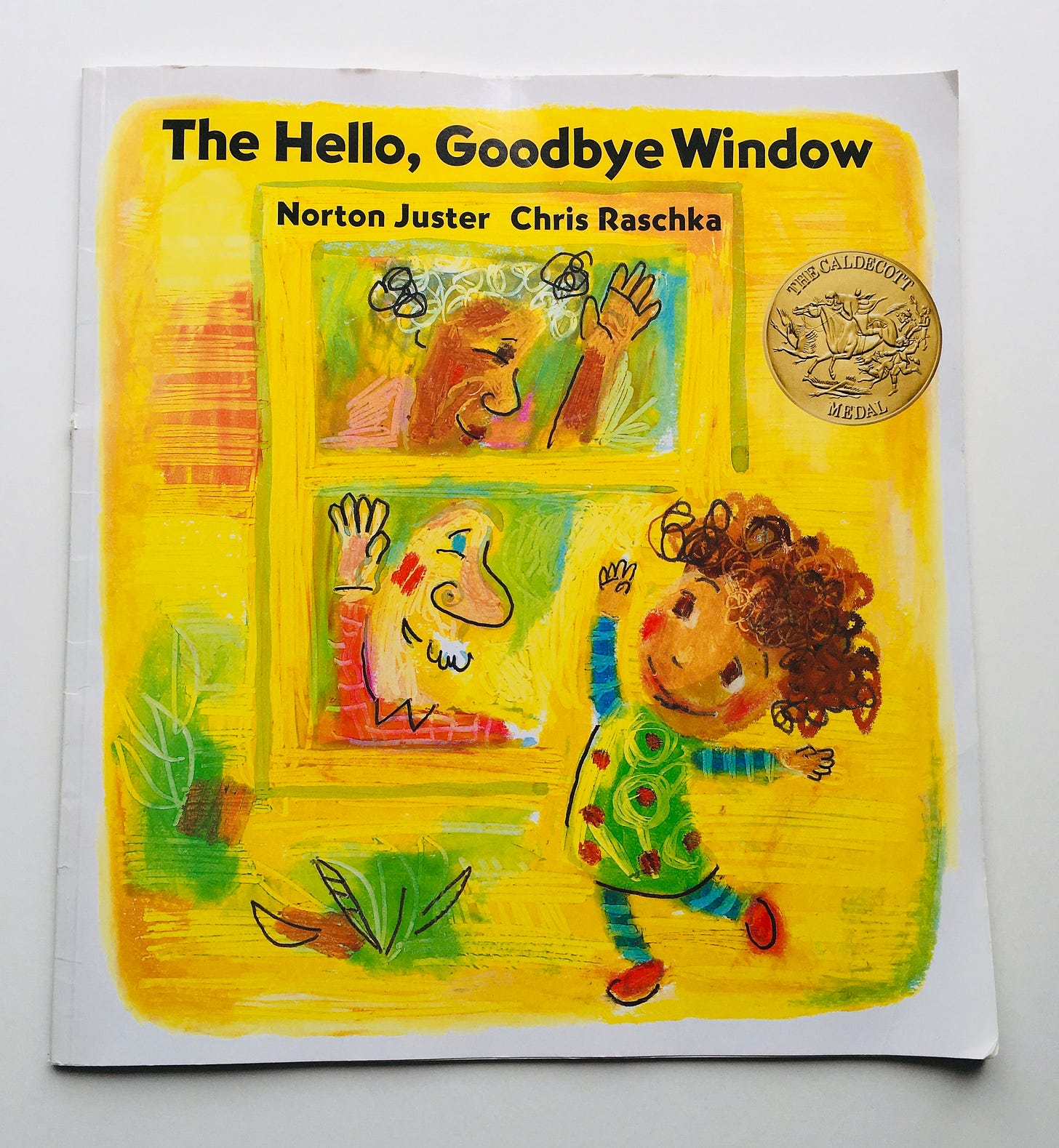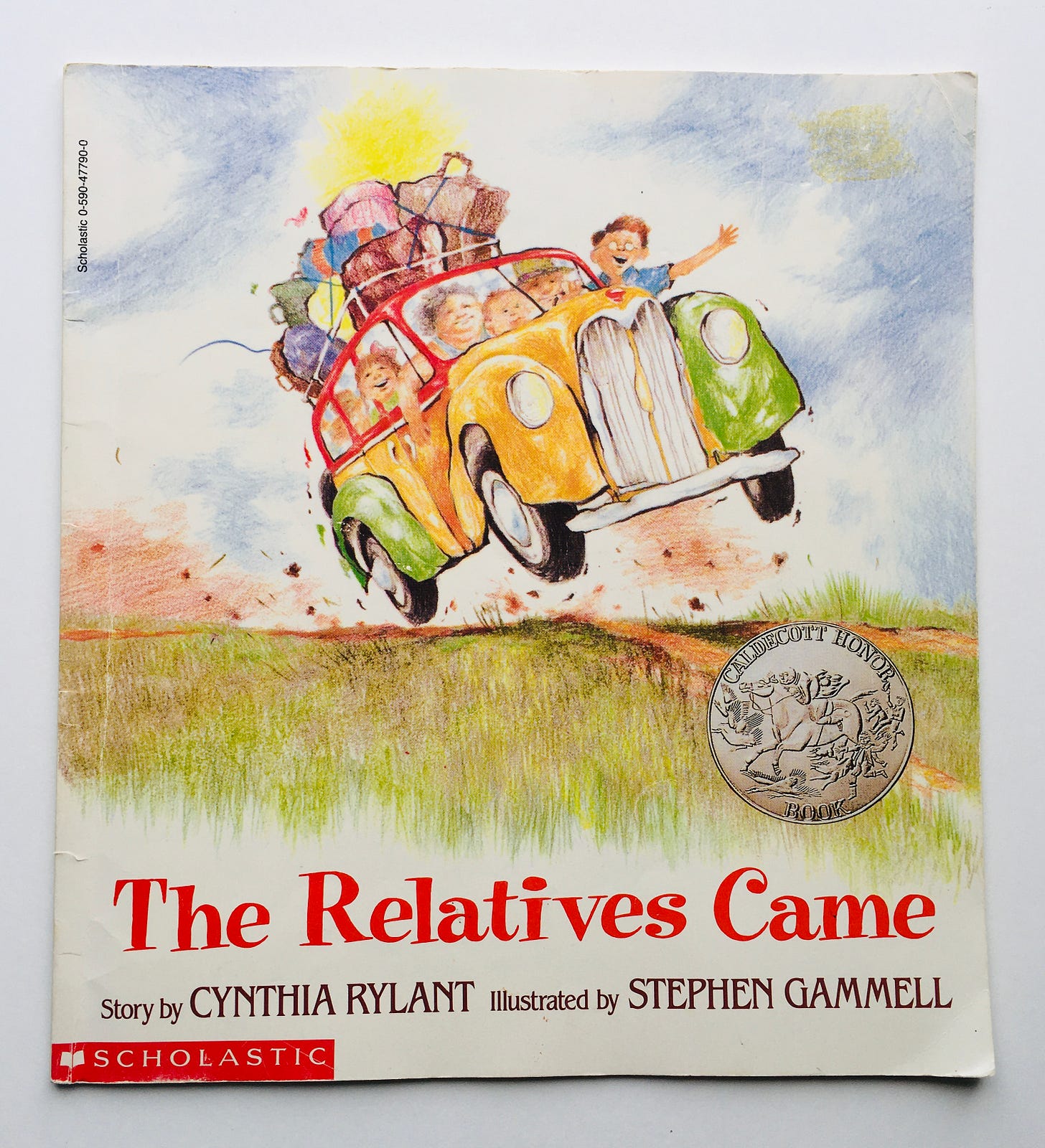Can we read? No. 6
Good morning, happy Wednesday, let’s talk books.
The Hello, Goodbye Window by Norton Juster, illustrated by Chris Raschka (2005)

Okay, it’s true I am a sucker for grandparent books, but this one is such a worthy, loving tale. “Nanna and Poppy live in a big house in the middle of town. There’s a brick path that goes to the back porch, but before you get there you pass right by the kitchen window. That’s the Hello, Goodbye Window. It looks like a regular window, but it’s not.” The window is a touchpoint to keep returning to, as the reader follows along with a little one on a routine visit to her grandparents’ house, complete with all the wonder, comfort, and magic that entails. Raschka’s illustrations are thick and warm, allowing the reader to almost literally see the love across generations. The window is the place to say hello, and of course, also the place to say goodbye, but it also seems to be a window that provides a deeper view: into the heart of the home and the hearts of those who live there.
The Relatives Came by Cynthia Rylant, illustrated by Stephen Gammell (1985)

Anyone who has ever had extended family visit (perhaps for an extended period of time) can appreciate this title, which is full of the realism of large special occasions — in this case, when a pile of people arrive from far away. There is crying and hugging, eating and singing, talking and sleeping in close quarters without enough beds. It’s not surprising this story is based on Rylant’s real-life experience: the family traditions and the feeling that some things never change, even while everything changes, is almost palpable. This is a lively depiction of an exuberant family, happy to see one another once a year, happy to deal with whatever inconvenience arises — as they often do — when the relatives come.
Wherever You Go by Pat Zietlow Miller, illustrated by Eliza Wheeler (2015)

I am not a fan of what I think of as high school graduation books for small children. You know the ones I mean — they’re often saccharine, don’t tell any kind of story, fail at even the lowest level of poeticism. They’re books adults want to read, not books kids want to read (and the marketing is all mixed up there). Still, there are exceptions — I tend to make them if the messaging is particularly good, if it’s explicitly about how much a child is loved or about the important of believing in oneself. Wherever You Go doesn’t fall into either of those categories, which makes me wonder why I like this book, then I only have to open it to remember: oh yes, Wheeler’s illustrations as just as perfect as ever (see also and especially Miss Maple’s Seeds). The story is about, ostensibly, roads — where they take you, where you choose to go. This is a metaphor, of course, and it may or may not be understood as such by children, but the message here is a lovely and necessary one: “Roads take you all over the planet, but then… you can always follow them home again.”
Alfie’s Feet by Shirley Hughes (1982)

I’m sure the fact that I read the Alfie and Annie Rose books as a child myself contributes to my abiding love for them, but only partly: they’re simply excellent books (that stand on their own from my nostalgia). Shirley Hughes has an undeniable gift in coming up with stories that matter to children — she understands children and the ins and outs of their world in a singular, rare way (even in the world of children’s books) — but for me, at least as a parent, it’s her illustrations that make her one of the most beloved authors of all time. Alfie and Annie Rose (not just in this title, but all of them) live in a real house with real parents — things are messy, food and drink gets spilled, there are toys and books and cups of tea everywhere, Mom and Dad always have a vague look of exhausted calm on their faces — and that doesn’t seem particularly special except when you realize how rarely that particular reality is represented in more modern titles (especially post-2000, which probably says something very deep about our culture). Alfie’s Feet has all this goodness and more: Alfie gets new rain boots but there’s something not quite right about them. He eventually figures it out and so do we — that is, that there is great meaning for children in even in the most ordinary events of the most ordinary days. (And really, that’s not such a bad philosophy for living a life, is it?)
Big Sarah’s Little Boots by Paulette Bourgeois, illustrated by Brenda Clark (1987)

Of course I had to pair two rain boots books together: what’s the point of writing my own newsletter, otherwise? Like Alfie, Sarah needs new rain boots — but unlike Alfie, she is extremely resistant to getting them. (Raise your hand if you have ever gone through this in your home, with even the most raggedy, toe-pinching footwear: no, you cannot wear your summer sandals in December, and please stop digging in the Goodwill closet, again ✋🤦🏻♀️) Sarah struggles like a mad woman to make her old boots fit — Clark’s illustrations shine here, with some superb depictions of Sarah’s determined, frustrated facial expressions; my favorite shows her watering her boots, planted in the garden in an attempt to get them to grow — but of course, they’re too small for her. She and her mother must go to purchase new ones and this in itself is another vexation. It’s a process for Sarah to accept her new boots, and a process for her to give her old ones to her little brother — to the author’s true credit, no one pushes Sarah through this faster than she can handle, she’s allowed the space to make her own way there — and I appreciate how damn relatable it all is: change is hard. Even when it’s just a (seemingly) little thing. No matter how old you are.
Thanks for reading.

